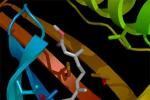Juvenile hormone receptor
Juvenile hormone (JH) is a terpenoid, a small lipophilic molecule of vital importance to insect development and reproduction. JH was so named for its capacity to block metamorphosis of larvae to adults: only when larvae attain an appropriate stage, a halt of JH secretion permits metamorphosis. Larvae treated with JH fail to mature, and therefore compounds with JH activity serve as efficient insecticides. The molecular action of JH has for long decades remained an enigma, because a JH receptor could not be identified. In 1986, T.G. Wilson isolated a Drosophila mutant, named Methoprene-tolerant (Met) based on resistance to the JH-mimicking insecticide. The Met gene encodes a transcription factor of the bHLH-PAS family, which includes a receptor of the xenobiotic dioxin but no receptors of known hormones. Breakthrough data from our laboratory in 2007 showed that Met is required for JH to inhibit metamorphosis in the beetle Tribolium like depletion of JH itself, loss of Met caused precocious metamorphosis of the beetle larvae. Our current paper, published by PNAS, has finally brought conclusive evidence for the JH receptor role of Met. Based on structural modeling of the JH-binding domain of Met, we prepared a set of point mutations aiming to displace JH from the ligand-binding pocket. By testing these mutant proteins in vitro, we determined specific amino acids contributing to the high-affinity JH binding. Using mutants unable to bind JH, we demonstrated that recently observed interactions of Met with partner proteins require the specific ligand-binding capacity of Met. Therefore, Met resembles certain nuclear receptors, e. g., of retinoic acid or thyroid hormone, but since Met belongs to a different protein family, it establishes a prototype of a hormonal receptor of a novel class. Our results address a long-standing question of the mechanism of action of juvenile hormone and its insecticidal analogs.















